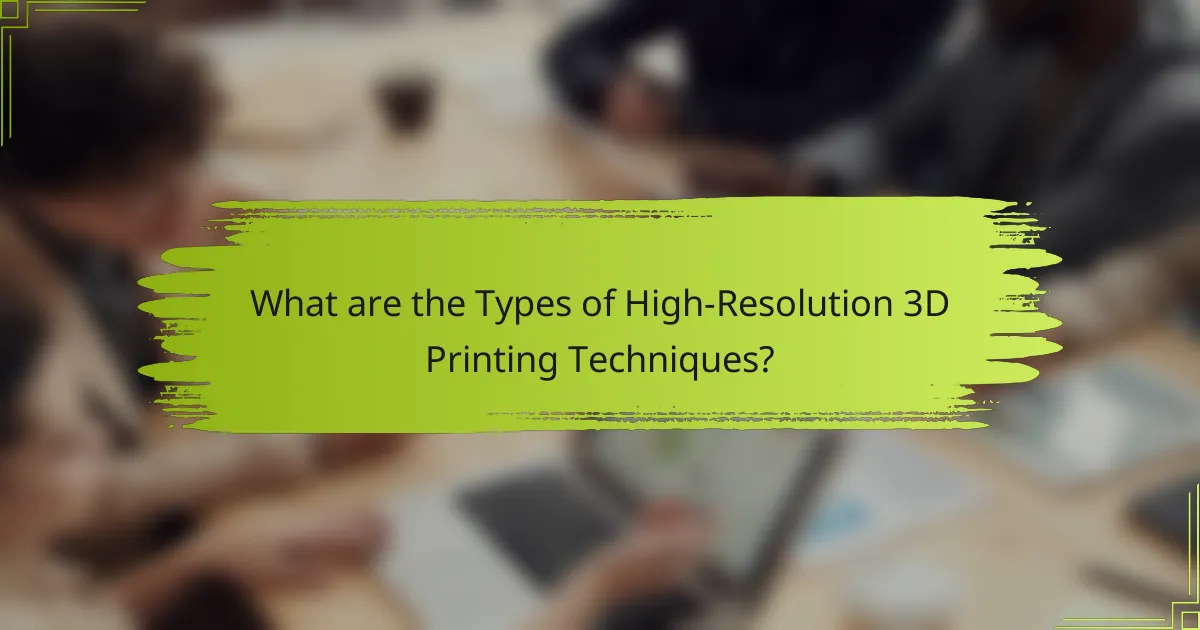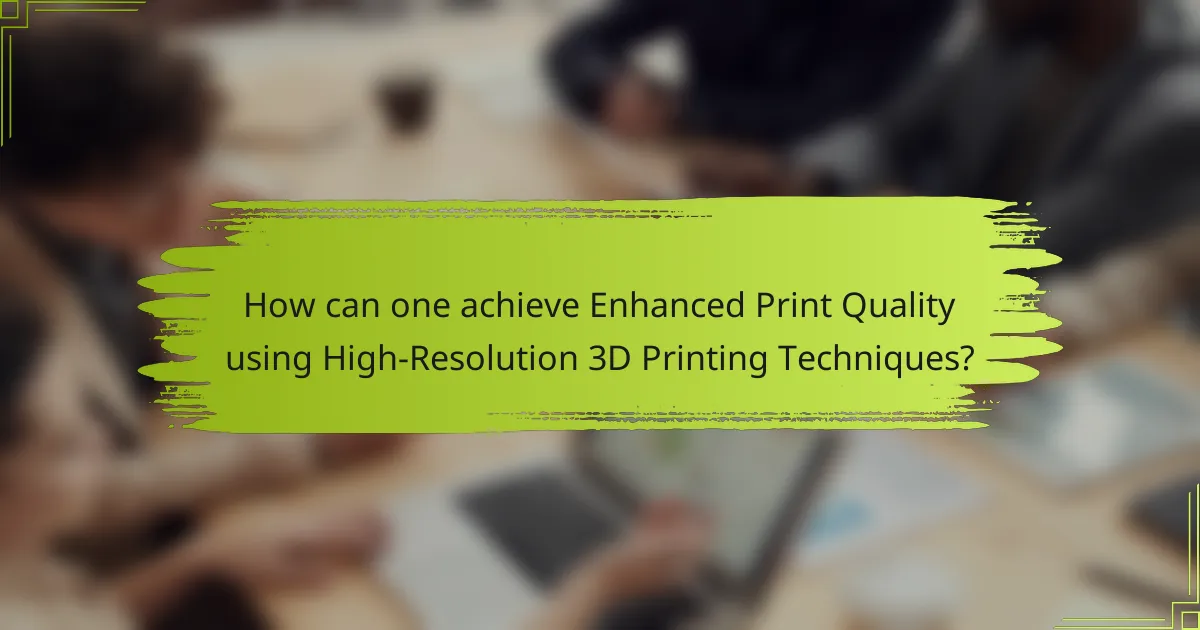
What are High-Resolution 3D Printing Techniques?
High-resolution 3D printing techniques refer to advanced methods that produce detailed and precise 3D printed objects. These techniques include processes such as Stereolithography (SLA), Digital Light Processing (DLP), and Multi-Jet Modeling (MJM). SLA uses a laser to cure liquid resin layer by layer, achieving high detail and smooth surfaces. DLP employs a digital light projector to cure resin quickly, enhancing speed without sacrificing resolution. MJM utilizes multiple jets to deposit materials, allowing for intricate designs and fine details. These methods are crucial in industries like aerospace and healthcare, where precision is vital. High-resolution techniques can achieve layer resolutions as fine as 25 microns, significantly improving the quality of printed parts.
How do High-Resolution 3D Printing Techniques differ from traditional methods?
High-resolution 3D printing techniques differ from traditional methods primarily in their ability to produce finer details and smoother surfaces. Traditional 3D printing methods, such as Fused Deposition Modeling (FDM), typically use thicker layers, which can result in visible layer lines. In contrast, high-resolution techniques, like Stereolithography (SLA) and Digital Light Processing (DLP), utilize liquid resin and UV light to cure layers with high precision.
These methods can achieve layer thicknesses as low as 25 microns, compared to FDM’s average of 100 to 300 microns. High-resolution printing allows for intricate designs and complex geometries that traditional methods may struggle to replicate. Furthermore, the materials used in high-resolution techniques often provide better surface finishes, reducing the need for post-processing.
Research shows that high-resolution 3D printing can produce parts with dimensional tolerances as tight as ±0.1 mm, significantly outperforming traditional methods. This increased accuracy and detail make high-resolution techniques ideal for applications in industries like dentistry and aerospace, where precision is critical.
What are the key characteristics of High-Resolution 3D Printing Techniques?
High-resolution 3D printing techniques feature precise layer resolution and fine detail reproduction. These techniques utilize advanced technologies like SLA and SLS. They enable the production of intricate geometries and complex designs. High-resolution prints often exhibit smooth surface finishes. They require specialized materials that can withstand fine printing processes. Speed is typically balanced with quality to optimize production efficiency. These techniques are widely used in industries such as aerospace and healthcare. Enhanced print quality leads to improved functionality and aesthetics in final products.
What advancements have led to the development of High-Resolution 3D Printing Techniques?
Advancements in materials, software, and hardware have led to the development of high-resolution 3D printing techniques. Improved photopolymers enable finer detail and smoother finishes. Advanced slicing software enhances layer management and print precision. Developments in laser technology increase resolution and speed. High-resolution nozzles allow for smaller extrusion diameters. Enhanced calibration methods ensure accurate layer alignment. These advancements collectively contribute to superior print quality and detail.
Why is Enhanced Print Quality important in 3D Printing?
Enhanced print quality is important in 3D printing because it directly affects the accuracy and detail of printed objects. High-resolution prints produce finer details and smoother surfaces. This results in parts that better match their digital models. Enhanced quality also improves the functional performance of parts. For instance, precise dimensions ensure proper fit and assembly. Additionally, high-quality prints reduce the need for post-processing. This saves time and resources in production. Ultimately, enhanced print quality leads to higher customer satisfaction and trust in 3D printed products.
How does Enhanced Print Quality impact the final product?
Enhanced print quality significantly improves the final product’s appearance and functionality. High-resolution 3D printing techniques create more precise and detailed models. This precision reduces visible layer lines and enhances surface smoothness. Improved surface finish contributes to better aesthetic appeal. Enhanced print quality also increases the structural integrity of the product. Stronger bonds between layers lead to greater durability. Additionally, fine details can enhance the product’s usability and performance. For example, intricate features can improve fit and function in mechanical applications.
What are the common challenges faced in achieving Enhanced Print Quality?
Common challenges in achieving enhanced print quality include material limitations, printer calibration issues, and environmental factors. Material limitations involve the compatibility of filaments with specific printers. Some materials may not adhere well or may warp during the printing process. Printer calibration issues can lead to misalignment and inconsistent layer deposition. This misalignment affects overall print fidelity. Environmental factors such as temperature and humidity can also impact print quality. Fluctuations in these conditions can cause defects like stringing or layer separation. Additionally, the complexity of the design can present challenges. Intricate designs may require higher precision, which can be difficult to achieve consistently.

What are the Types of High-Resolution 3D Printing Techniques?
The types of high-resolution 3D printing techniques include Stereolithography (SLA), Digital Light Processing (DLP), Selective Laser Sintering (SLS), and Multi-Jet Modeling (MJM). SLA uses a laser to cure liquid resin into solid objects layer by layer. DLP employs a digital light projector to achieve similar results but typically at faster speeds. SLS utilizes a laser to fuse powdered materials, creating durable parts. MJM works by depositing multiple materials simultaneously for detailed models. Each technique offers unique advantages, making them suitable for various applications in industries like aerospace and healthcare.
What are the most popular High-Resolution 3D Printing Techniques?
The most popular high-resolution 3D printing techniques include Stereolithography (SLA), Digital Light Processing (DLP), and Selective Laser Sintering (SLS). SLA uses a laser to cure liquid resin layer by layer, achieving high detail and smooth surfaces. DLP also cures resin but uses a digital light projector for faster printing. SLS employs a laser to fuse powdered material, creating durable parts with intricate geometries. These techniques are favored for their ability to produce fine details and complex designs, essential in industries like aerospace and healthcare.
How does Stereolithography (SLA) contribute to Enhanced Print Quality?
Stereolithography (SLA) enhances print quality through its layer-by-layer resin curing process. This technique allows for high precision and detail in 3D printed objects. SLA uses a laser to selectively cure liquid resin, resulting in smooth surface finishes. The layer thickness can be as low as 25 microns, contributing to finer details. SLA’s ability to produce intricate geometries is superior to many other methods. This capability is crucial for applications requiring detailed prototypes and complex designs. The accuracy of SLA prints can reach tolerances of ±0.1 mm. This precision is validated by numerous studies highlighting SLA’s effectiveness in producing high-quality prints.
What role does Selective Laser Sintering (SLS) play in High-Resolution 3D Printing?
Selective Laser Sintering (SLS) is a key technology in high-resolution 3D printing. SLS utilizes a laser to fuse powdered material, layer by layer, creating detailed and complex geometries. This method allows for high precision and excellent surface finish in printed parts. SLS is particularly effective with materials like nylon and polyamides. The process supports intricate designs that traditional manufacturing cannot achieve. Additionally, SLS minimizes the need for support structures, enhancing design freedom. Studies show that SLS can achieve layer resolutions as fine as 0.1 mm. These characteristics make SLS vital for applications requiring high accuracy, such as aerospace and medical devices.
What are the benefits of using High-Resolution 3D Printing Techniques?
High-resolution 3D printing techniques offer several significant benefits. They produce highly detailed and accurate prints. This precision allows for intricate designs that are often not possible with lower resolution methods. High-resolution printing also enhances surface finish quality. Smoother surfaces reduce the need for post-processing. Additionally, these techniques enable the use of advanced materials. This expands the range of applications in industries like healthcare and aerospace. Research shows that high-resolution prints can improve functional performance. For instance, they can create complex geometries that optimize strength-to-weight ratios.
How do these techniques improve design flexibility?
High-resolution 3D printing techniques improve design flexibility by enabling intricate geometries and customizations. These techniques allow for complex shapes that traditional methods cannot achieve. They support the use of various materials, enhancing the range of applications. Additionally, they facilitate rapid prototyping, which accelerates the design iteration process. This adaptability leads to more innovative solutions tailored to specific needs. The ability to modify designs easily during the printing process further enhances flexibility. According to a study published in the Journal of Additive Manufacturing, these advancements significantly reduce constraints in product development.
What cost advantages do High-Resolution 3D Printing Techniques offer?
High-resolution 3D printing techniques offer significant cost advantages through material efficiency and reduced waste. These techniques utilize precise layer deposition, minimizing excess material use. As a result, manufacturers can lower material costs by optimizing usage. Additionally, high-resolution printing reduces the need for post-processing, saving time and labor expenses. This efficiency can lead to faster production cycles, contributing to lower overall operational costs. According to a study by Wohlers Associates, companies using advanced 3D printing technologies can achieve cost savings of up to 70% compared to traditional manufacturing methods. This demonstrates the economic benefits of high-resolution 3D printing in various applications.

How can one achieve Enhanced Print Quality using High-Resolution 3D Printing Techniques?
To achieve enhanced print quality using high-resolution 3D printing techniques, one should utilize advanced printer settings and materials. Adjusting layer height to a lower value improves detail and surface finish. Selecting high-quality filament enhances the final product’s appearance and strength. Implementing proper calibration of the printer ensures accurate dimensions and reduces errors. Utilizing a heated print bed minimizes warping and improves adhesion. Employing post-processing techniques, such as sanding or painting, can further refine the surface quality. Research indicates that printers with higher nozzle temperatures can produce smoother finishes by allowing better filament flow. These methods collectively contribute to achieving superior print quality in high-resolution 3D printing.
What best practices should be followed for Enhanced Print Quality?
Use high-quality materials for enhanced print quality. Quality materials provide better adhesion and surface finish. Select the appropriate nozzle size for the desired detail. Smaller nozzles allow for finer details, while larger nozzles increase speed. Maintain a clean print bed to ensure proper adhesion. A clean surface prevents warping and improves the first layer. Optimize print settings for layer height and speed. Lower layer heights improve detail, while slower speeds enhance accuracy. Regularly calibrate the printer to maintain precision. Calibration ensures that the printer operates within its optimal parameters. Monitor environmental conditions like temperature and humidity. Stable conditions prevent issues like warping and layer separation.
How does material selection affect print quality?
Material selection significantly impacts print quality in 3D printing. Different materials possess varying properties that influence the final output. For instance, PLA offers excellent detail and surface finish, while ABS provides greater durability but can warp. The viscosity of the material affects how it flows through the printer nozzle. A material with higher viscosity may result in less precise layer adhesion. Additionally, the thermal properties of the material can affect how well it bonds with previous layers. Materials that cool too quickly may lead to cracking or poor adhesion. Research shows that using the appropriate material can enhance layer resolution and overall print fidelity. Therefore, careful selection of materials is crucial for achieving high-quality prints.
What settings should be optimized for better results?
Print speed, layer height, and temperature should be optimized for better results in high-resolution 3D printing. Reducing print speed enhances detail and reduces artifacts. A smaller layer height increases resolution and improves surface finish. Temperature settings affect material flow and adhesion. Adjusting these parameters can lead to significant improvements in print quality. Studies indicate that optimal layer height can reduce print time while maintaining detail.
What common troubleshooting tips exist for High-Resolution 3D Printing?
Ensure proper bed leveling to prevent adhesion issues. Use a clean build surface for optimal material adherence. Adjust the nozzle temperature according to the filament type for better flow. Monitor layer height settings to achieve desired print resolution. Check for filament quality to avoid clogs and inconsistencies. Maintain a consistent printing speed to enhance detail. Regularly clean the nozzle to prevent buildup. Update firmware and slicer settings for improved performance and compatibility.
How can one resolve layer adhesion issues?
Increase print temperature to improve layer adhesion. Higher temperatures allow the filament to flow better and bond with previous layers. Ensure the nozzle temperature is appropriate for the material used. For PLA, a temperature of 200-220°C is often effective. Additionally, adjust the print speed; slower speeds can enhance adhesion. A speed reduction of 10-20% may yield better results.
Optimize the cooling settings as well. Insufficient cooling can lead to warping, affecting adhesion. Use a cooling fan but at a moderate setting to prevent rapid cooling. Adjusting bed temperature can also help. A heated bed at 60°C for PLA can enhance adhesion. Finally, consider using adhesion promoters like glue sticks or painter’s tape on the print bed. These methods have been shown to improve adhesion significantly in various 3D printing scenarios.
What steps can be taken to avoid print defects?
To avoid print defects, ensure proper calibration of the 3D printer. Calibration includes adjusting the nozzle height and bed level. Regularly clean the printer components to prevent material buildup. Use high-quality filament to reduce inconsistencies in print quality. Monitor the printing environment for temperature and humidity control. Implement a consistent print speed to enhance layer adhesion. Conduct test prints to identify potential issues before full production. Finally, regularly update the printer firmware to improve performance and compatibility.
High-resolution 3D printing techniques encompass advanced methods such as Stereolithography (SLA), Digital Light Processing (DLP), and Selective Laser Sintering (SLS), which produce detailed and precise printed objects. These techniques differ from traditional methods by achieving finer details and smoother surfaces, with layer resolutions as low as 25 microns. Key characteristics include enhanced print quality, improved design flexibility, and significant cost advantages, making them essential in industries like aerospace and healthcare. The article also addresses the advancements that have led to these techniques, challenges in achieving enhanced print quality, and best practices for optimizing results.